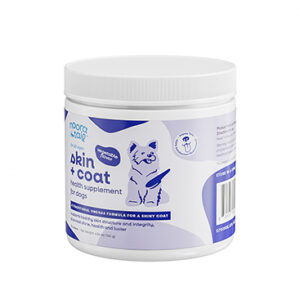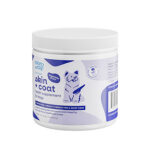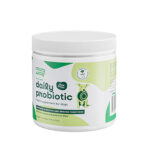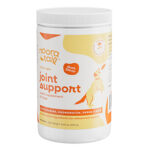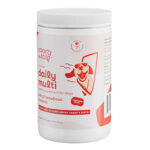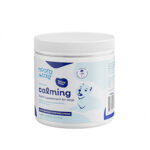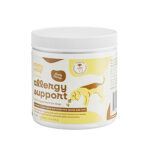Dog Dandruff: Causes and Treatment

Dog dandruff, also known as dry skin or seborrhea, is a common skin condition that affects many dogs. It can cause a variety of symptoms, including:
- White or gray flakes of skin on the coat
- Itching
- Reddened skin
- Hair loss
Dandruff can be caused by a variety of factors, including:
- Dry skin: This is the most common cause of dandruff in dogs. It can be caused by a lack of moisture in the air, or by exposure to harsh chemicals or detergents.
- Allergies: Dogs can be allergic to a variety of things, including food, pollen, and dust mites. Allergies can cause dandruff, as well as other skin problems.
- Hormonal imbalances: Hormonal imbalances can also lead to dandruff. These imbalances can be caused by a variety of factors, including thyroid disease, Cushing’s syndrome, and Addison’s disease.
- Parasites: Some parasites, such as mites and fleas, can cause dandruff. These parasites can irritate the skin, leading to inflammation and flaking.
- Bacterial or yeast infections: Bacterial or yeast infections can also cause dandruff. These infections can lead to inflammation and flaking, as well as other skin problems.
Diagnosing the cause of your dog’s dandruff is important in order to determine the best course of treatment. Your veterinarian will ask you about your dog’s symptoms, and may perform a physical examination and/or skin scraping.
Treatment for dog dandruff will depend on the underlying cause. In some cases, simply changing your dog’s diet or adding a humidifier to your home may be enough to resolve the problem. In other cases, medication or even surgery may be necessary.
Here are some tips for preventing and treating dog dandruff:
- Brush your dog regularly: Brushing your dog regularly will help to remove dead skin cells and distribute natural oils throughout the coat. This can help to prevent dry skin and dandruff.
- Use a gentle shampoo: When bathing your dog, use a gentle shampoo that is designed for dogs with sensitive skin. Harsh shampoos can strip the skin of its natural oils, leading to dryness and dandruff.
- Avoid harsh chemicals: Avoid using harsh chemicals or detergents on your dog’s skin. These chemicals can irritate the skin and lead to dandruff.
- Keep your dog’s environment clean: Keep your dog’s environment clean and free of allergens. This will help to reduce your dog’s exposure to potential allergens that could trigger dandruff.
- See your veterinarian regularly: If your dog has dandruff, it is important to see your veterinarian regularly. Your veterinarian can help to diagnose the underlying cause of your dog’s dandruff and recommend the best course of treatment.
Dandruff is a common problem, but it can be managed with proper care. By following these tips, you can help to keep your dog’s skin healthy and free of dandruff.
Determine the Cause:

As a beloved dog owner, it’s natural to be concerned when you notice flakes of dandruff falling from your furry companion’s coat. While it can be a common skin condition, dandruff in dogs can signal underlying issues that require attention. Here’s a comprehensive guide to help you determine the root cause of your dog’s dandruff and take appropriate steps to address it:
1. Examine Your Dog’s Skin
The first step in pinpointing the cause of your dog’s dandruff is to carefully examine their skin. Look for any signs of dryness, redness, or irritation. Dry skin is a common culprit of dandruff, as it causes the skin to shed excessive dead skin cells. Redness and irritation can indicate inflammation or an underlying skin condition that needs veterinary care.
2. Consider Dietary Changes
Your dog’s diet can play a significant role in their skin health. If you’ve recently switched your dog’s food or introduced new treats, consider whether these changes have coincided with the onset of dandruff. Some dogs may be allergic or sensitive to certain ingredients in their food, which can manifest as skin issues, including dandruff.
3. Check the Environment
Environmental factors can also contribute to dandruff in dogs. Dry air, extreme temperatures, and exposure to harsh chemicals can dehydrate the skin and lead to flaking. Check the humidity levels in your home, especially during winter months, and consider using a humidifier to add moisture to the air.
4. Assess Grooming Habits
Improper or infrequent grooming can worsen dandruff. Brush your dog regularly to remove dead hair and distribute natural oils throughout the coat. Bathing can also help remove excess skin cells and debris, but avoid over-bathing as it can strip the skin of its natural oils. Choose a gentle shampoo formulated for dogs and use warm water to rinse thoroughly.
5. Rule Out Underlying Medical Conditions
In some cases, dandruff in dogs can be a symptom of an underlying medical condition. If you notice other signs, such as excessive itching, hair loss, or skin infections, it’s crucial to consult your veterinarian. Skin conditions like allergies, mange, and thyroid disorders can cause dandruff and require specific treatment.
6. Consider Parasites
Parasites, such as fleas and mites, can irritate the skin and cause dandruff. Regularly check your dog for signs of parasites and keep their flea and tick prevention up to date.
7. Address Stress
Believe it or not, stress can also trigger dandruff in dogs. Stress can cause hormonal imbalances and suppress the immune system, leading to skin problems. Providing a calm and stress-free environment, as well as regular exercise and mental stimulation, can help reduce stress and improve skin health.
8. Consult a Veterinarian
If you’re unable to determine the cause of your dog’s dandruff or if it persists despite home remedies, it’s essential to consult a veterinarian. They can perform a thorough examination, diagnose any underlying medical conditions, and recommend appropriate treatment options.
Conclusion
Dandruff in dogs can be an indication of various factors, ranging from dry skin to underlying medical conditions. By carefully examining your dog’s skin, considering their diet, environment, and grooming habits, you can often identify the cause and take steps to alleviate the issue. However, if the dandruff is severe or persists, don’t hesitate to seek professional veterinary care to ensure your furry companion receives the proper diagnosis and treatment.
Rule Out Allergies:
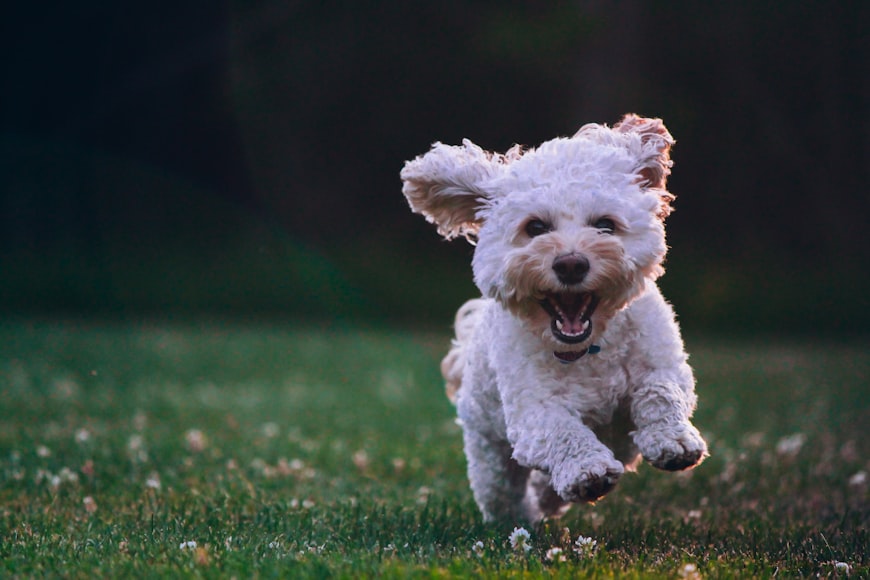
Dandruff, characterized by white flakes of skin, can be a common and frustrating issue for dog owners. While often perceived as a minor inconvenience, severe dandruff can indicate an underlying health problem that requires attention.
Common Causes of Dandruff in Dogs
Several factors can contribute to dandruff in dogs, including:
- Allergies: Food allergies, environmental allergens (such as pollen or dust mites), and parasites (such as fleas or mites) can trigger an allergic reaction that manifests as dandruff.
- Dry Skin: A lack of moisture in the skin can lead to dryness, flaking, and the appearance of dandruff.
- Skin Infections: Bacterial or fungal infections on the skin can cause inflammation, itching, and the production of excessive skin cells, resulting in dandruff.
- Underlying Medical Conditions: Certain medical conditions, such as hypothyroidism (an underactive thyroid gland) or Cushing’s disease (an overactive adrenal gland), can cause skin changes, including dandruff.
Rule Out Allergies: A Key Diagnostic Step
Allergies are a common cause of dandruff in dogs, so ruling them out is crucial for effective treatment.
Food Allergies:
- Symptoms of food allergies include not only dandruff but also gastrointestinal issues such as vomiting, diarrhea, and gas.
- A veterinarian may recommend an elimination diet to determine if a particular food ingredient is causing the allergy.
Environmental Allergies:
- Environmental allergies are harder to pinpoint, but common culprits include pollen, dust mites, and mold.
- Allergy testing can help identify specific allergens and develop an effective avoidance plan.
Parasite Allergies:
- Fleas and mites are common parasites that can cause allergic reactions and dandruff.
- Regular flea and tick prevention can help control infestations and alleviate symptoms.
Additional Diagnostic Measures
In addition to ruling out allergies, other diagnostic measures may be necessary to determine the underlying cause of dandruff in your dog.
- Physical Examination: A veterinarian will examine your dog’s skin, coat, and ears for any signs of infection or underlying skin conditions.
- Skin Culture: A skin culture can help identify bacterial or fungal infections.
- Blood Tests: Blood tests can assess your dog’s thyroid function and overall health.
Treatment and Prevention
The treatment for dandruff will depend on the underlying cause. Common treatments include:
- Allergy Management: Avoiding allergens, using medication, or administering allergy shots can reduce allergic reactions and improve skin health.
- Moisturizing: Regularly applying a dog-specific moisturizer can help hydrate the skin and reduce dryness.
- Medication: Antibiotics or antifungal medications may be prescribed to treat skin infections.
- Underlying Medical Condition Management: Addressing underlying medical conditions can improve skin health and reduce dandruff.
Prevention Tips
- Regularly brush your dog’s coat to remove dead skin cells and prevent matting.
- Bathe your dog frequently with a gentle, hypoallergenic shampoo.
- Use a humidifier in your home to increase air moisture and prevent dry skin.
- Monitor your dog for any signs of allergies or skin irritation.
- Keep your dog’s environment clean and free of potential allergens.
Conclusion
Dandruff in dogs can be a symptom of a variety of underlying causes, from allergies to skin infections. By ruling out allergies and pursuing appropriate diagnostic and treatment measures, you can help your furry friend overcome this common skin condition and restore their healthy, vibrant coat. Remember, if you are concerned about your dog’s skin health, it is always a good idea to consult with a veterinarian for professional advice and guidance.
Treat Underlying Skin Conditions:

Dandruff, characterized by excessive flaking skin, is a common skin condition that can affect dogs of all ages and breeds. While not usually a serious health concern, it can be a nuisance and indicate underlying skin issues. Understanding the causes and implementing effective treatment strategies can help you alleviate your furry friend’s discomfort.
Causes of Dandruff in Dogs
Dandruff in dogs can stem from various factors, including:
- Dry skin: Lack of moisture in the skin can lead to a buildup of dead skin cells, resulting in dandruff.
- Underlying skin conditions: Yeast infections, dermatitis, and bacterial infections can disrupt the skin’s normal balance and cause excessive skin shedding.
- Nutritional deficiencies: A diet lacking essential nutrients, such as omega-3 fatty acids, can lead to dry, flaky skin.
- Allergies: Environmental allergens like pollen, dust, or certain foods can trigger an allergic reaction, causing skin irritation and dandruff.
- Poor grooming: Insufficient brushing and bathing can contribute to the accumulation of dead skin cells and dandruff.
Treating Canine Dandruff
Addressing the underlying cause is crucial for effective dandruff treatment. Here are some common approaches:
1. Regular Brushing and Bathing:
- Regularly brushing your dog helps remove loose hair and dead skin cells, reducing dandruff buildup.
- Use a de-shedding brush for double-coated breeds.
- Bathe your dog with a mild, hypoallergenic shampoo formulated for canine skin. Avoid over-bathing, as this can strip the skin of its natural oils.
2. Moisturizing:
- Apply a pet-safe moisturizer to your dog’s skin after bathing to hydrate and soothe dry skin.
- Consider using a leave-in conditioner or a hydrating spray for dogs with severely dry skin.
3. Treat Underlying Skin Conditions:
- If skin conditions like yeast infections, dermatitis, or other bacterial infections are present, treat them accordingly.
- Prescribed medications or medicated shampoos may be necessary.
4. Dietary Changes:
- Ensure your dog is receiving a balanced diet that meets their nutritional needs.
- Include foods rich in omega-3 fatty acids, such as salmon or fish oil supplements, to nourish the skin and coat.
5. Environmental Control:
- If allergies are suspected, try to identify and eliminate potential triggers from your pet’s environment.
- Use hypoallergenic bedding and cleaning products to reduce exposure to irritants.
When to Seek Veterinary Advice
While dandruff is typically a manageable condition, it’s important to consult a veterinarian if:
- The dandruff persists despite home remedies.
- Your dog experiences other symptoms, such as hair loss, itching, or skin redness.
- You suspect an underlying skin condition.
Conclusion
Dandruff in dogs can be a nuisance, but it can also indicate underlying health issues. By understanding the causes and implementing proper treatment measures, you can effectively alleviate your furry companion’s discomfort. Regular grooming, a balanced diet, and addressing any underlying skin conditions are all essential for keeping your dog’s skin healthy and dandruff-free. If your dog’s dandruff is severe or persistent, don’t hesitate to seek professional veterinary advice.
Maintain Proper Hygiene:

As a caring pet owner, your dog’s well-being is paramount. Skin conditions, such as dandruff, can be a concern that affects not only their appearance but also their comfort. Understanding the causes and implementing appropriate remedies is crucial to maintain healthy skin and a happy canine companion.
What is Dandruff and What Causes It?
Dandruff, medically known as exfoliative dermatitis, refers to the excessive shedding of dead skin cells, resulting in visible flakes on your dog’s coat. It is a common condition that can be caused by various factors, including:
- Dry skin: The most prevalent cause of dandruff is dry skin, which can arise from a lack of moisture, weather conditions, or underlying health issues.
- Yeast overgrowth: Malassezia pachydermatis is a yeast that can thrive on dogs’ skin and produce irritants that trigger dandruff.
- Skin infections: Bacterial or fungal infections can lead to inflammation and flaking of the skin.
- Allergies: Environmental or food allergies can cause itchy skin and dandruff as a secondary symptom.
- Underlying medical conditions: Certain hormonal disorders, thyroid imbalances, or immune system deficiencies can also manifest as dandruff.
Effective Remedies to Combat Dandruff
Addressing the underlying cause of dandruff is essential for effective treatment. Here are several practical remedies to alleviate your dog’s discomfort and restore healthy skin:
1. Maintain Proper Hygiene:
- Bathe your dog regularly with a gentle, moisturizing shampoo specifically formulated for dogs. Avoid using harsh shampoos or soaps that can further dry out the skin.
- Consider using a shampoo containing oatmeal or aloe vera, which have soothing and anti-inflammatory properties.
- Rinse your dog thoroughly after bathing to remove any residual shampoo.
2. Moisturize Regularly:
- Apply a dog-friendly moisturizer or leave-in conditioner to your dog’s coat after bathing. This will help to hydrate the skin and reduce flaking.
- Consider using a coconut oil-based moisturizer, as coconut oil has antibacterial and antifungal properties.
3. Omega-3 Fatty Acids:
- Supplement your dog’s diet with omega-3 fatty acids, which have anti-inflammatory properties that can improve skin health. Fish oil is a rich source of omega-3s.
4. Diet Management:
- If your dog has allergies, identify and avoid the allergens that trigger their dandruff.
- Provide your dog with a balanced diet that meets their nutritional needs and supports healthy skin.
5. Medicated Shampoos:
- In cases where dandruff is caused by a bacterial or fungal infection, your veterinarian may prescribe medicated shampoos containing antibacterial or antifungal agents.
6. Environmental Modifications:
- Use a humidifier in your home to increase air moisture, which can help alleviate dry skin.
- Provide your dog with access to fresh water at all times.
- Avoid exposing your dog to extreme temperatures or harsh chemicals.
7. Consult a Veterinarian:
- If your dog’s dandruff persists despite home remedies, it is important to consult a veterinarian. They can determine the underlying cause and recommend appropriate treatment, such as medication or dietary changes.
Conclusion:
Dandruff in dogs can be a bothersome condition that affects their comfort and appearance. By understanding the causes and implementing effective remedies, you can help your canine companion regain healthy skin and a flake-free coat. Maintaining proper hygiene, moisturizing regularly, managing their diet, and seeking veterinary care when necessary will ensure that your furry friend enjoys a happy and itch-free life.
Use Moisturizers:
As a loving dog owner, nothing pains you more than seeing your furry friend struggling with a pesky problem like dandruff. While not life-threatening, dandruff can cause discomfort, itching, and even secondary infections if left untreated.
Understanding Doggy Dandruff
Dandruff, known as seborrhea in veterinary terms, is a common skin condition characterized by excessive flaking of the skin’s outer layer. The flakes typically appear white or gray and can be accompanied by other symptoms such as itching, redness, and a greasy or dry coat.
There are several potential causes behind dog dandruff, including:
- Dry Skin: Lack of moisture can weaken the skin’s natural barrier, leading to flaking.
- Allergies: Allergies to food, environmental allergens, or even shampoos can trigger dandruff.
- Yeast or Bacterial Infections: An overgrowth of yeast or bacteria on the skin can cause irritation and flaking.
- Autoimmune Disorders: Underlying autoimmune conditions can affect skin health and contribute to dandruff.
- Poor Diet: A diet deficient in essential nutrients, such as omega-3 fatty acids, can compromise skin health.
Treating Doggy Dandruff
Treating dog dandruff effectively requires addressing the underlying cause. Here are some common remedies:
1. Regular Bathing:
Bathing your dog with a gentle, pH-balanced shampoo specifically formulated for dogs helps remove excess flakes and dirt. Use lukewarm water and avoid over-washing, as this can further dry out the skin.
2. Medicated Shampoos:
If regular bathing alone is ineffective, consider using medicated shampoos containing antifungal or antibacterial ingredients to target specific skin infections. Consult your veterinarian before using any medicated shampoos.
3. Oatmeal Baths or Sprays:
Colloidal oatmeal has soothing and anti-inflammatory properties that can relieve skin irritation and reduce flaking. You can add colloidal oatmeal to your dog’s bath or use a leave-in spray.
4. Moisturizers and Leave-In Conditioners:
Apply pet-friendly moisturizers or leave-in conditioners to hydrate the skin and reduce flaking. Look for products containing humectants, such as hyaluronic acid or glycerin, which help draw moisture into the skin.
5. Omega-3 Fatty Acids:
Omega-3 fatty acids are essential for maintaining healthy skin and coat. Consider adding fish oil supplements or foods rich in omega-3s to your dog’s diet to improve skin hydration.
6. Dietary Changes:
If allergies are suspected, eliminate potential allergens from your dog’s diet and consult with your veterinarian for recommendations. Ensure your dog is getting a balanced and nutritious diet that meets their individual needs.
7. Antibiotic or Antifungal Medications:
In severe cases of infection, your veterinarian may prescribe antibiotics or antifungal medications to treat the underlying cause of the dandruff.
Preventing Doggy Dandruff
Preventing dandruff is just as important as treating it. Here are a few tips:
- Brush your dog regularly to remove loose hair and dirt.
- Avoid harsh grooming products that can strip the skin of its natural oils.
- Protect your dog from extreme weather conditions, such as cold and dry air, which can exacerbate dry skin.
- Provide a clean and comfortable living environment for your dog.
- Address any underlying health conditions that may contribute to dandruff.
Conclusion
Doggy dandruff can be a frustrating problem, but with proper diagnosis and treatment, you can help your furry companion achieve a healthy, flake-free coat. Remember to observe your dog closely for any signs of discomfort or worsening symptoms, and consult your veterinarian for professional guidance and support. By following these tips and working closely with your vet, you can ensure a happier and healthier life for your beloved pet.
Provide a Healthy Diet:
As a loving dog owner, nothing breaks our hearts more than seeing our furry companions struggle with uncomfortable skin conditions like dandruff. Dandruff, characterized by excessive shedding of dead skin flakes, can be a frustrating problem for both dogs and their humans.
Causes of Dandruff in Dogs
Before embarking on a treatment plan, it’s essential to understand the underlying causes of dandruff in dogs:
- Dry Skin: Insufficient moisture can lead to dryness, flaking, and dandruff. This can occur due to factors such as cold weather, low humidity, or certain medical conditions.
- Nutritional Deficiencies: A lack of essential nutrients, particularly omega-3 fatty acids, can impair skin health and contribute to dandruff.
- Allergies: Dogs can develop allergies to various substances, including food, pollen, and dust mites. These allergies can trigger inflammation and skin irritation, leading to dandruff.
- Parasites: Fleas, ticks, and mites can cause skin irritation and exacerbate dandruff.
- Medical Conditions: Certain medical conditions, such as Cushing’s disease, hypothyroidism, and liver disease, can affect skin health and result in dandruff.
Effective Solutions for Dog Dandruff
To effectively address dog dandruff, a holistic approach that tackles both the underlying cause and the symptoms is recommended.
Provide a Healthy Diet:
- Feed your dog a high-quality diet rich in omega-3 fatty acids, which promote skin health. Sources of omega-3s include fish oil, chia seeds, and flaxseed.
- Avoid foods that may trigger allergies or worsen dandruff, such as certain grains, dairy products, or wheat.
Maintain Proper Moisture Levels:
- Humidify your home during dry seasons or consult a veterinarian about using a humidifier specifically designed for dogs.
- Bathe your dog regularly with a gentle, moisturizing shampoo. Avoid harsh detergents and soaps that can strip the skin of its natural oils.
- Apply a leave-in conditioner or moisturizer to help keep the skin hydrated.
Address Allergens and Parasites:
- If you suspect allergies, consult a veterinarian for allergy testing and develop a plan to avoid the allergens.
- Treat any parasite infestations promptly with appropriate medications prescribed by a veterinarian.
- Regularly groom your dog to remove loose hair, dander, and any parasites.
Manage Medical Conditions:
- If an underlying medical condition is causing dandruff, it’s crucial to seek veterinary care to address the underlying cause and alleviate the skin condition.
Other Tips:
- Brush your dog daily to distribute natural oils and remove loose dander.
- Avoid excessive bathing, as this can further strip the skin of its natural oils.
- Provide plenty of clean, fresh water to promote overall hydration.
- Keep your dog’s bedding and other belongings clean to minimize exposure to allergens and parasites.
Conclusion
Dog dandruff can be an uncomfortable and frustrating issue, but with proper care and attention, it can be effectively managed. By addressing the underlying cause, implementing a healthy diet, and maintaining proper skin care routines, pet owners can help their furry companions find relief from dandruff and enjoy healthy, comfortable skin. It’s always recommended to consult with a qualified veterinarian for personalized advice and treatment recommendations.
Control Environmental Factors:
As dog owners, we cherish the bond we share with our furry companions. However, even the most beloved pooches can occasionally develop skin ailments, including the dreaded dandruff. Dandruff, characterized by dry, flaky skin, can be unsightly and uncomfortable for our canine friends. But fear not, for there are effective ways to alleviate this condition and restore your dog’s healthy skin.
Understanding the Causes
Dandruff is typically caused by an underlying skin condition known as seborrhea. This condition occurs when the skin produces excessive sebum, an oily substance that helps protect and lubricate the skin. In some dogs, sebaceous glands overproduce sebum, leading to a buildup of dead skin cells and the formation of dandruff.
Several factors can contribute to seborrhea, including:
- Dietary deficiencies: A lack of essential nutrients, such as vitamin A, omega-3 fatty acids, or zinc, can disrupt the skin’s health.
- Allergies: Environmental allergens, such as pollen, dust, or mold, can trigger an allergic reaction that causes skin irritation and dandruff.
- Medical conditions: Underlying health problems, such as hypothyroidism or Cushing’s disease, can affect the skin’s function and lead to seborrhea.
- External parasites: Fleas and mites can irritate the skin and cause excessive scratching, leading to dandruff.
- Environmental factors: Dry air, excessive heat, or cold weather can draw moisture from the skin, exacerbating dandruff.
Treatment Options: Addressing the Root Cause
Addressing the underlying cause of dandruff is crucial for long-term management. If you suspect your dog has allergies, consult a veterinarian for allergy testing and treatment recommendations. For dogs with hypothyroidism or Cushing’s disease, medical treatment will be necessary to control the condition and improve skin health. If external parasites are present, treat them promptly with appropriate medications.
Home Remedies: Soothing and Moisturizing
In addition to addressing the root cause, several home remedies can help soothe and moisturize your dog’s skin, reducing dandruff.
- Oatmeal Baths: Oatmeal has anti-inflammatory and moisturizing properties that can soothe irritated skin. Grind oatmeal into a powder and mix it with lukewarm water to create a soothing bath for your dog.
- Coconut Oil: Coconut oil is a natural moisturizer that helps hydrate the skin. Apply a small amount to your dog’s coat, taking care to avoid the eyes and mouth.
- Aloe Vera: Aloe vera gel has cooling and soothing properties that can calm skin irritation. Apply a small amount directly to the affected areas.
Control Environmental Factors:
Managing environmental factors can also help alleviate dandruff.
- Use a humidifier: Introducing moisture into the air can help prevent the skin from drying out, especially during dry seasons.
- Protect your dog from excessive heat or cold: Extreme temperatures can dry out the skin, so keep your dog comfortable in moderate temperatures.
Diet and Nutrition:
Ensuring your dog receives a well-balanced diet rich in essential nutrients can promote healthy skin. Consider adding omega-3 fatty acid supplements to your dog’s diet, as these have anti-inflammatory properties that can improve skin health.
Grooming:
Regular grooming is essential for removing dead skin cells and reducing the buildup of dandruff. Brush your dog’s coat several times a week to remove loose hair and dander.
When to Seek Professional Help
While home remedies and environmental management can often control dandruff, it’s important to consult a veterinarian if the condition persists or worsens. Your vet can diagnose the underlying cause and recommend appropriate treatment options, such as medicated shampoos or antibiotics.
Conclusion
Dandruff in dogs is a common skin condition that can be effectively managed with the right approach. By addressing the underlying cause, implementing home remedies, controlling environmental factors, and providing a healthy diet, you can help your beloved canine companion regain healthy, flake-free skin. Remember that every dog is unique, so work closely with your veterinarian to develop a personalized treatment plan that addresses your dog’s specific needs. With patience and care, you can restore your dog’s skin health and bring back their shiny, happy coat.
Stay Vigilant:
Dandruff, the annoying white flakes that can accumulate on your dog’s skin and coat, is a common issue that can affect any breed. While it’s not usually a serious medical condition, it can be a sign of underlying health problems or discomfort for your furry friend. As responsible pet owners, it’s crucial to stay vigilant and take appropriate steps to tackle this issue.
Understanding the Causes of Dandruff
Dandruff in dogs can be caused by a variety of factors, including:
- Dry skin: A lack of natural oils can lead to dry, flaky skin that sheds excess cells.
- Skin allergies: Environmental allergens like pollen, dust, and certain foods can trigger an allergic reaction that causes skin irritation and dandruff.
- Yeast infections: Malassezia pachydermatis, a type of yeast that lives on the skin of most dogs, can overgrow and cause inflammation and dandruff.
- Hormonal imbalances: Thyroid issues or other hormonal problems can disrupt the skin’s normal function, leading to dryness and dandruff.
- Poor nutrition: A diet lacking essential nutrients can affect skin health and contribute to dandruff.
Recognizing the Signs and Symptoms
Dandruff is characterized by white or gray flakes that accumulate on your dog’s skin and coat. It’s often more noticeable on dark-colored dogs. Other signs of dandruff include:
- Dry, flaky skin
- Redness and irritation
- Itching and scratching
- Hair loss in severe cases
Stay Vigilant: Monitoring Your Dog’s Skin
Regularly monitoring your dog’s skin condition is essential for early detection and prompt treatment of dandruff. Here are some tips:
- Brush your dog regularly to remove dead skin cells and loose dandruff.
- Examine your dog’s skin for any signs of redness, inflammation, or flaking.
- Pay attention to your dog’s behavior. Excessive scratching or licking can indicate skin discomfort caused by dandruff.
Addressing Dandruff Effectively
If you notice signs of dandruff on your dog, it’s important to seek veterinary guidance promptly. Your veterinarian will examine your dog and determine the underlying cause of the dandruff. Based on the diagnosis, they will recommend the appropriate treatment plan, which may include:
- Anti-dandruff shampoos and conditioners
- Topical medications to reduce inflammation and kill yeast
- Prescription allergy medications
- Dietary changes to improve skin health
- Veterinary-approved grooming products
Preventive Measures
While not all cases of dandruff can be prevented, there are steps you can take to reduce the risk of future episodes:
- Regular grooming: Brushing your dog regularly removes dead skin cells, stimulates natural oil production, and helps prevent dryness.
- Balanced diet: Feed your dog a high-quality, nutrient-rich diet that supports skin health.
- Environmental control: Minimize your dog’s exposure to known allergens that trigger skin irritation.
- Regular veterinary checkups: Annual or semi-annual veterinary exams allow your veterinarian to assess your dog’s overall health and check for any developing skin problems.
Conclusion
“My Dog Has Dandruff” is a common concern among pet owners. By staying vigilant, monitoring your dog’s skin condition, and addressing dandruff promptly, you can effectively manage this issue and ensure your furry companion enjoys a healthy, comfortable life. Remember, prevention is key, and routine grooming, a balanced diet, and regular veterinary checkups play a vital role in maintaining your dog’s skin health.









